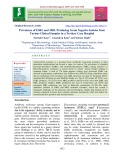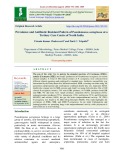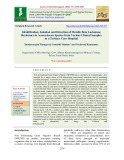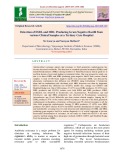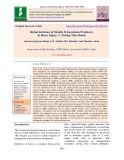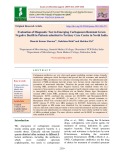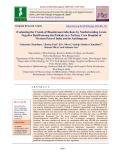
Combined disc diffusion test
-
Antimicrobial resistance is a growing threat worldwide. Increasing resistance to third generation cephalosporins has become a cause for concern. The prevalence of extended spectrum–lactamases (ESBLs) and metallobetalactamases (MBL) among members of Enterobacteriaceae constitutes a serious threat to current -lactam therapy leading to treatment failure. A total of 276 Gram negative isolates were processed. ESBL was detected by phenotypic confirmatory disc diffusion test (PCDDT) using ceftazidime alone and in combination with clavulanic acid.
 8p
8p  angicungduoc6
angicungduoc6
 20-07-2020
20-07-2020
 19
19
 1
1
 Download
Download
-
The aim of this study was to analyze the extended spectrum of β lactamase (ESBL), metallo β lactamase (MBL) and AmpC production in Pseudomonas aeruginosa in various clinical samples. A Total of 100 clinical isolates of P. aeruginosa were collected from different clinical specimen and confirmed by standard tests. Antibiotic susceptibility was determined by the Kirby-Bauer disc diffusion method. ESBL screening was done using 3rd generation cephalosporins and confirmatory combined double disc test, imipenem-EDTA double disc synergy test for MBL enzyme and AmpC test using Cefoxitin disc.
 9p
9p  trinhthamhodang1213
trinhthamhodang1213
 30-05-2020
30-05-2020
 11
11
 1
1
 Download
Download
-
Non fermenting Gram Negative Bacilli (NFGNB) once considered as contaminants, now emerged as a major cause of life threatening nosocomial infections and as multidrug resistant pathogens. Acinetobacter species are the opportunistic pathogens with increasing prevalance in the nosocomial infections. Community acquired infections are also common in Acinetobacter. It accounts for 10% of all community-acquired bacteremic pneumonias. To isolate, identify and detect Carbapenem resistance producing Acinetobacter spp., and confirm Metallo Beta Lactamase ( MBL) production by phenotypic methods.
 10p
10p  trinhthamhodang5
trinhthamhodang5
 16-05-2020
16-05-2020
 15
15
 1
1
 Download
Download
-
Antimicrobial resistance pattern and resistance to third generation cephalosporins has become increased worldwide. The detection of extended spectrum lactamases (ESBLs) and metallobetalactamases (MBLs) among members of Enterobacteriaceae family guide us to use Beta lactam, if not tested leading to treatment failure. One year prospective study, our aim is to detect ESBL and MBL producing gram negative bacilli from various clinical samples. A total of 100 Gram negative bacilli were processed.
 7p
7p  caygaocaolon3
caygaocaolon3
 09-03-2020
09-03-2020
 20
20
 0
0
 Download
Download
-
One of the common causes of morbidity and mortality following burn injury is infections. The emergence of metallo-β-lactamase (MBL) in Gram negative bacilli (GNB) has reduced the available therapeutic options for effective treatment. Therefore, for screening of carbapenemase producers, a simple and inexpensive testing method is essential. To know the prevalence of MBL production in various gram negative isolates, to evaluate different phenotypic methods to detect MBL production and to find out antibiotic sensitivity profile of MBL producing gram negative bacilli.
 9p
9p  quenchua2
quenchua2
 15-12-2019
15-12-2019
 14
14
 0
0
 Download
Download
-
Carbapenem antibiotics are very often used against multidrug resistant strains clinically troublesome pathogens which developed and proved that the resistance and metallo-βlactamases (MBL) production were a disaster in treating infections. The identification and detection of MBL-producing bacterial strains were having crucial importance for the prevention of nosocomial infections. Therefore the present study was undertaken for screening MBL production Gram Negative bacteria.
 8p
8p  quenchua2
quenchua2
 15-12-2019
15-12-2019
 13
13
 1
1
 Download
Download
-
Non-fermenting gram-negative bacilli (NFGNB) are an emerging problem in Blood stream infections. A major concern is multi-drug resistance which severely limits treatment options. Earlier it was believed to be non pathogenic, but recently they are more frequently isolated as primary pathogen. Usually they cause hospital acquired infection (HAI). A prospective study was conducted to isolate the NFGNB from blood samples, to identify the risk factors leading to blood stream infections and to determine the antibiotic susceptibility pattern of them.
 14p
14p  nguaconbaynhay1
nguaconbaynhay1
 04-12-2019
04-12-2019
 17
17
 1
1
 Download
Download
CHỦ ĐỀ BẠN MUỐN TÌM








